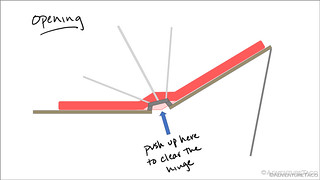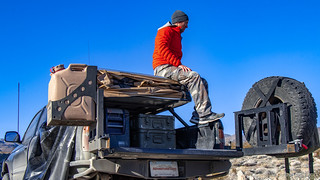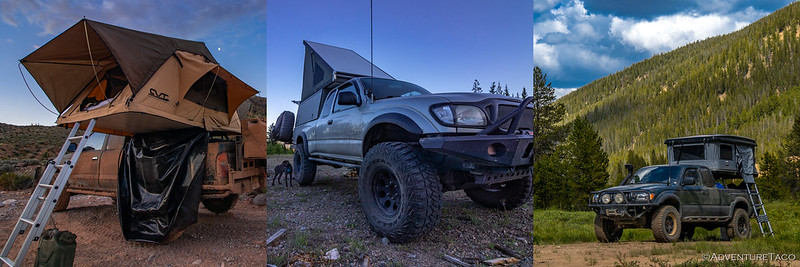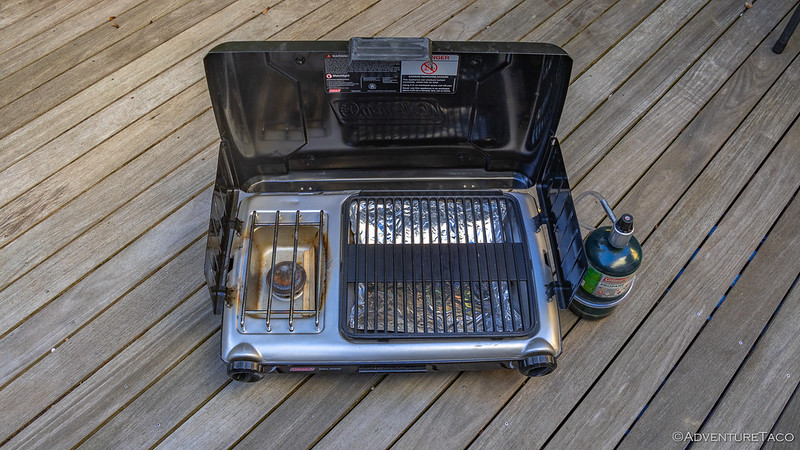So after having my Exped MegaMat 10 Duo LXW for a little over a year - during which time I've spent about 90 nights on it - I figured it was time to share my long-term impressions as well as a few things I've learned. "Pro tips" as it were... or at least, "tips."  I should also note here that I'm not sponsored by Exped in any way, and I paid full price for my mattress. I'm just a fanboi, and want to help others get a great night sleep.
I should also note here that I'm not sponsored by Exped in any way, and I paid full price for my mattress. I'm just a fanboi, and want to help others get a great night sleep.
TL;DR - I really like the Exped. Of everything I've done to make camping more enjoyable - including all the truck mods - it is my #2 mod of them all. Only the ARB Fridge is more valuable in my mind. So yeah, I recommend picking one up as soon as you can.
A Refresher on the Exped for New Folks
If you're curious what the Exped is, I'd recommend reading the Rig Review where I first got it. Essentially, it's a combination foam/air mattress that comes in three sizes, where you can almost always find a size (or combination) that will fit nicely in an RTT.
- for a 56" wide tent, get the Exped MegaMat Duo 10 LXW (Long & Wide) at 78" x 52"
- for a 48" wide tent, get the Exped MegaMat Duo 10 (Medium) at 72" x 41"
- for a single sleeper, get the Exped MegaMat 10 LXW at 77" x 30"

Get to the Actual Review Already
A year ago, I wrestled for several months about whether or not I wanted to purchase the Exped MegaMat 10 Duo LXW. For the last two years, @mrs.turbodb and I had been sleeping on the mattress that came with the CVT Mt. Shasta (Standard Pioneer) tent, and while it was "OK," it had some issues:
- We'd both sometimes wake up with our hips hurting.
- On very cold nights (low 30s), it was a battle to keep warm - heat seemed to escape below us, through the mattress.
- On all but the warmest of nights, we'd have condensation on the bottom inside of the tent, from our body heat/moisture - that was escaping through the mattress - condensing on the floor of the tent. Note: Originally this got the bottom of the mattress wet, but I quickly purchased an anticondensation matt, which kept the mattress above the condensation.
Eventually, I decided to bite the bullet on the ~$350 (when I bought it) MegaMat. This cost is the largest negative aspect of the mattress in my opinion. It's expensive!
That said, sleeping on the MegaMat is amazing. The combination of foam and air means several things:
- It's comfortable. It's both as firm and as soft as you want it to be. I've found in the past that air-only mattresses are either very firm or feel under-inflated and your hips, shoulders, etc. end up on the ground. The Exped allows for firmness adjustment by adding air, but the 3.9-inch thick foam gives a constant softness and cushioning that is like sleeping on a real mattress. Even sleeping on our sides, hips and shoulders are never on the floor of the tent.
- The MegaMat is warm. Both the foam and air contribute to this as well. The foam (understandably) provides insulation, but it's the air that I believe is the real magic. By trapping a layer of air in the mattress, your body heat can heat up the air in the mattress, and that air can't escape - unlike the OEM RTT mattress. That trapped warm air in turn warms the insulating foam, keeping you toasty even on the coldest of nights.
- It's dry. The great insulation also means there is no condensation. At all. This continues to surprise me, but every morning I check under the Exped and anticondensation mat to see if I need to wipe up any condensation on the bottom of the tent, and I never do. That's how well the Exped keeps heat on the top of the mattress near your body, and away from the bottom of the mattress where it could condense on the cold tent floor.
- The mattress is sized well for most RTTs. When I put it into the CVT Mt. Shasta (a 2+ tent), it was exactly the right width - as though it was made specifically for the purpose. That means you aren't rolling off the side of the mattress onto the cold floor during the night.
- The mattress compresses significantly more/better than the original mattress. I would say that it compresses to no more than 1/2" thick when folded up with the tent, making more room for pillows and sleeping bags, and resulting in a tent that is much easier to close.
- Weight. It's light(er than the original air mattress).
- Last, but far from least - @mrs.turbodb loves it as well. This is a valuable attribute in my book, as her happiness on trips correlates directly to the number of trips she goes on!

So that's all the best stuff, what are the drawbacks?
- Cost. Just get over it. I'm sure you've done a worse job spending the same amount of money on something in the past!

- The hand pump. Like any air mattress, if you want to get a little extra loft/firmness, you have to pressurize it a little bit. The hand pump that is supplied to do this works, but is a bit of a pain since it's slow.
- Size. The Exped is ~80" long which is about 16" shorter than the length of a fold-out RTT (which is 96" long). This is minor, because it turns out you can't really use the 8" closest to either of the tent doors anyway - the angled sides of the tent mean that area isn't tall enough to fit your head. We put our clothes, books, etc. in that space, since they don't need a comfy mattress to sleep on. Note: if you take your dog into your tent, and want your dog to sleep at your feet and on the mattress, this may be an issue for you; otherwise, width is what matters, and that's perfect.
- Holes. Like any air mattress, it can get a hole in it, and then it won't work all that well. The solution is the same as any air mattress - carry a patch kit and solve any hole in 5 minutes. Note: I've never gotten a hole, but I'm a very careful guy when it comes to my gear.
All of these drawbacks - in my opinion - are solved simply, and are easily outweighed by the drawbacks of any other mattress solution, so none of them bother me at all. Well, the cost still does, but I just try not to think about it.
Pro Tips for Using the Exped
Here are 9 little things you can do to make your Exped experience even better. In no particular order.
1 If you open your tent at least 30 min before you are going to bed, your Exped will self-inflate part of the way. That means less pumping with the little hand pump before you lay on it.
2 When you are pumping up the Exped, do it from the outside of your tent, not when you're inside and laying on the mattress. No need to be pushing air into something you are laying on.
3 Be careful when opening and closing your tent, so you don't catch the Exped in the hinge (and possibly make a hole). A few points worth noting as part of this process:
- The problem point is a very small one - it's right at the "joint" between the two halves of the tent - where the hinge pivots/scissors together as it opens and closes.
- The solution requires either 2 people or a bit of coordination and strength, as it entails moving the mattress during the fold/unfold process.
OK, so those things said, let's talk about closing first, since that will be the first operation you do with an Exped, and because it's easier.
As you push up half the tent using the ladder, slow down (but continue to support the ladder with one hand) when you're between 90 and 75 degrees to the other half. At this point, you have plenty of access to the center fold of the mattress. Take advantage of the fact that the mattress is 18" shorter than the tent, and push/slide it "forward" (away from the hinge) with your other hand so that you can see the entire hinge, and the ends of the mattress (and your bedding) will be pushed away from the middle and into the corners of the tent. At this point, you'll have plenty of room to store your tent poles on the hinge side, and the hinges won't be pinching the Exped.

...and opening...
Essentially the reverse of closing, as you open the tent, support the half that's folding out using the ladder in one hand. Then, with the other, as the seam/hinge is starting to close, push the mattress up from the bottom so that it is "above" (or at least next to) the hinge. The way the hinge works, it scissors closed as the tent opens, and so ensuring that the matress is out of that scissoring area is your goal here.

4 After you fold your tent closed, climb up the side of your truck and sit on the tent to compress the Exped. You'll hear air rushing out as you do this, and pretty soon, it'll be super easy to snap together the straps that keep the two halves of the tent closed. You won't have to cinch down or anything.

5 Never try to inflate the Exped by blowing air into it. You don't want to get your humid breath inside the mattress where it might condense and eventually mildew. If you just can't stand the hand pump that comes with it, get a small 12v mattress inflator. They all have multiple nozzles and one will be just the right size.
6 Be careful when you're in the tent and on the mattress. Jumping up and down - as well as other active "activities" - on your mattress will just lead to premature wear and possible even a hole. Move carefully, with purpose. Everything is better that way.
7 Stop bringing your pet into the tent. Those claws/toenails are a sure way to get a hole in your new Exped. And yes, you'll still end up with a hole even if you're careful and have a designated bed for your furry friend.
8 Make or purchase a fitted sheet for your Exped to keep it clean(er). It's a simple thing, and might seem overkill, but your future self will thank you. You paid a bunch of money for this mattress, so take good care of it.
9 Let out just a little bit of air once you're laying on it, to get it "just right." You can do this by opening the Fill valve (not the Release valve) and then depress the silicone check valve a little bit in order to let some air out. When the mattress is perfectly inflated, re-secure the rubber plug.
So, that's my review and a few tips after a little more than a year of use. If you've got your own feedback, or tips you think might help others, please share below!
In this Series





I don't have a roof top tent but due to your original review I bought an Exped mat for my ground tent. I agree with you in being worth every penny. Reading this article I had an idea for you to avoid pinching. What if you laid a piece of "Ram board" below the mattress. It is flexible and I think it would protect it and keep it out of the seam. The sell it at homedepot or Lowes.
That's a great suggestion Malcolm! While I've never actually heard of ram board, I do have an anticondensation matt that I use under the mattress, which is probably similar. It definitely helps with the seam between the tent halves, but the place that the mattress can still get pinched is in the hinges on the side (of the tent). Those hinges pinch the 4" side of the Exped, and can cause a hole there - which is why the pushing is necessary.
I think your point about having an Exped regardless of RTT vs. ground tent is a great one. I sure wish I'd had one of these in my ground tent days!
Thanks for the comment, and glad you're enjoying!
Thanks for the advice on "tent closing," my problem with the cover on my Sky Ridge tent is that the very heavy cover is so stiff and cut a bit small that even when the weather is hot and the tent is compressed the cover is a real bugger to get over the corners. I'm hoping that eventually it will stretch/soften a bit so that it's not so difficult to get it over the tent and zipped up. Thanks for the advice.